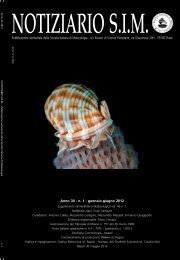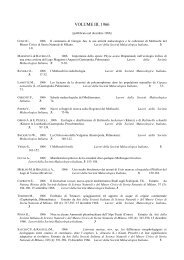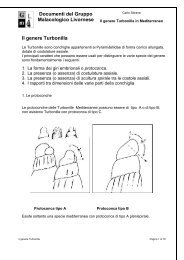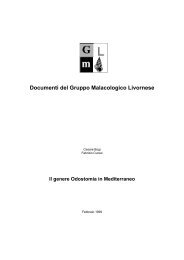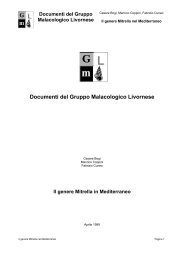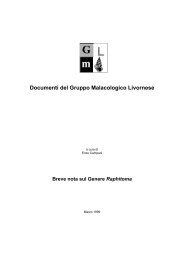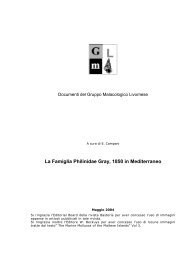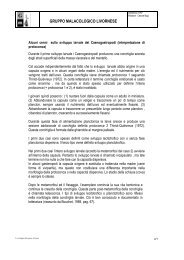scarica il Notiziario S.I.M. - SocietàItaliana di Malacologia
scarica il Notiziario S.I.M. - SocietàItaliana di Malacologia
scarica il Notiziario S.I.M. - SocietàItaliana di Malacologia
- No tags were found...
You also want an ePaper? Increase the reach of your titles
YUMPU automatically turns print PDFs into web optimized ePapers that Google loves.
Segnalazioni bibliograficheSegnalazioni bibliografiche24Continuiamo la segnalazione <strong>di</strong> lavori apparsi su rivisteitaliane e straniere che trattino <strong>di</strong> molluschi me<strong>di</strong>terranei,<strong>di</strong> molluschi terrestri, acquadulcicoli o <strong>di</strong> molluschifoss<strong>il</strong>i dell’area italiana. Ad ogni segnalazione viene aggiuntauna sintesi del riassunto riportato dagli Autori,ricordando che non viene fatta alcuna valutazione criticae che pertanto la responsab<strong>il</strong>ità del contenuto degliarticoli rimane degli Autori.Molluschi mariniCrocetta F. & Soppelsa O., 2006. Primi ritrovamenti<strong>di</strong> Rapana venosa (Valenciennes, 1846) per alcunelagune costiere italiane. Atti del Museo Civico <strong>di</strong> StoriaNaturale <strong>di</strong> Trieste, 52: 215-218.Gli autori segnalano i primi ritrovamenti <strong>di</strong> esemplariviventi <strong>di</strong> Rapana venosa (Valenciennes, 1846) per loStagno <strong>di</strong> Santa G<strong>il</strong>la (CA), la Laguna <strong>di</strong> Sabau<strong>di</strong>a(LT) e Lago <strong>di</strong> Faro (ME).Crocetta F. & Spanu M., 2008. Molluscs associatedwith a Sar<strong>di</strong>nian deep water population of Corallium rubrum(Linné, 1758). Me<strong>di</strong>terranean Marine Science, 9 (2):63-85.Mollusca species living in strict association with and onCorallium rubrum colonies are poorly known. Specimensfound on a red coral population located off Capo Caccia(Alghero - SS, West Sar<strong>di</strong>nia, Me<strong>di</strong>terranean Sea) werestu<strong>di</strong>ed by analyzing red coral branches collected at adepth of between 100 and 120 m.; their assemblage wasmade up of 44 species, all belonging to the classes Gastropodaand Bivalvia. Some data on the geographical<strong>di</strong>stribution, ecology, taxonomy and dominance of species,both alive and dead, are given and the most interestingare commented on. Among the recorded speciesTrivia mult<strong>il</strong>irata, Simnia purpurea, Corallioph<strong>il</strong>a brevis,Ocinebrina paddeui, Pleurotomella demosia, Palliolum striatumand Pseudamussium sulcatum deserve attention. Moreover,the second fin<strong>di</strong>ng of living specimens of Asperarcasecreta, described only on loose valves, is reported,and finally the prey-predator relationships among severalgastropods and Cnidarians are confirmed.I molluschi che vivono in stretta associazione con e sucolonie <strong>di</strong> Corallium rubrum sono scarsamente conosciuti.Gli esemplari trovati su una popolazione <strong>di</strong> corallorosso al largo <strong>di</strong> Capo Caccia (Alghero - SS, Sardegnaoccidentale, Mar Me<strong>di</strong>terraneo) sono stati stu<strong>di</strong>ati analizzandorami <strong>di</strong> corallo rosso raccolti ad una profon<strong>di</strong>tàcompresa tra 100 e 120 metri; la loro biocenosi eracostituita da 44 specie, tutte appartenenti alle classi Gastropodae Bivalvi. Vengono date alcune notizie sulla<strong>di</strong>stribuzione geografica, ecologia e dominanza dellespecie, sia viventi che morte e sono commentate le piùinteressanti. Tra le specie reperite Trivia mult<strong>il</strong>irata, Simniapurpurea, Corallioph<strong>il</strong>a brevis, Ocinebrina paddeui, Pleurotomellademosia, Palliolum striatum e Pseudamussiumsulcatum meritano particolare nota. Inoltre viene riportato<strong>il</strong> secondo ritrovamento <strong>di</strong> Asperarca secreta descrittasoltanto su valve sciolte ed infine sono confermate lerelazioni preda-predatore intercorrenti tra gasteropo<strong>di</strong> ecnidari.Dell’Angelo B., Giusti F., Paolini P., Sosso M. & BonfittoA., 2009. New data on Polyplacophora from TuscanArchipelago. I. Leptochiton sarsi Kaas, 1981 and Leptochitonpepezamorai Carmona Zalvide, Urgorri & Garcia,2004, two species new to the Me<strong>di</strong>terranean Sea.Italian Journal of Zoology, 76: 76-82.Two Atlantic species of Leptochiton, Leptochiton sarsi Kaas,1981 and Leptochiton pepezamorai Carmona Zalvide,Urgorri & Garcia, 2004, were found in the Tuscan Archipelago,at the Santa Lucia Bank. This area, between theCorsica and the Gorgona Island, is characterized by extensivewhite corals and hard bottom biocenosis exten<strong>di</strong>ngfrom 125 to 800 m, which is particularly rich inmolluscs. The two species were found looking over agreat amount of old detritus from a depth estimated near500 m. The study of L. sarsi (compared with someAtlantic specimens) and of Leptochiton pepezamorai permitus to better define some morphological features ofthis species, not well characterized in the original description.The collection of these Atlantic species in theMe<strong>di</strong>terranean Sea extend to 34 the number of speciesof Polyplacophora present in this area.Due specie atlantiche <strong>di</strong> Leptochiton, Leptochiton sarsi Kaas,1981 e Leptochiton pepezamorai Carmona Zalvide, Urgorri& Garcia, 2004, sono state trovate nell’Arcipelagotoscano, nel Banco <strong>di</strong> S. Lucia. Quest’area, compresa trala Corsica e l’isola <strong>di</strong> Gorgona, è caratterizzata da consistentiformazioni <strong>di</strong> corallo bianco e biocenosi <strong>di</strong> fondoduro, che si estendono da 125 ad 800 metri <strong>di</strong> profon<strong>di</strong>tà,ed è particolarmente ricca <strong>di</strong> molluschi. Le due speciesono state rinvenute esaminando una grande quantità<strong>di</strong> vecchio detrito proveniente da una profon<strong>di</strong>tàstimata <strong>di</strong> 500 metri. Lo stu<strong>di</strong>o <strong>di</strong> L. sarsi (confrontatocon esemplari atlantici) e <strong>di</strong> Leptochiton pepezamorai cipermette <strong>di</strong> definire meglio alcune caratteristiche mor-



